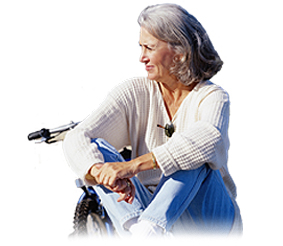Hip Pain SmartSiteTM | ||||||||||||||||||
Getting your home ready and safeDescriptionYou will be using crutches, a walker, or a cane to move around when you come home. To protect your hip and stay safe, you will need to be careful how you move and reach. Before you go to the hospital for surgery, set up your home to make your life easier when you come back. Do this well in advance of your surgery. Devices and equipment can make it easier for you to move around, dress, use the toilet, shower, and perform other daily tasks. Ask your doctor, nurse, or physical therapist about getting your home ready. Make it easy for yourselfMake sure everything you will need during the day is easy to get to and on the same floor where you will spend most of your time. If you will need to use the stairs, you should not have to go up and down them more than once a day. Have a bed that is low enough so that your feet touch the floor when you sit on the edge of the bed. You should also make sure the bed is not too low that it will be difficult for you to get up. Set it up on the first floor if you can. You will not need a hospital bed, but your mattress should be firm. Have a bathroom or a portable commode on the same floor where you will spend most of your day. Stock up on canned or frozen food, toilet paper, shampoo, and other personal items. Either buy or make single meals that can be frozen and reheated. Make sure you can reach everything you need without getting on your tiptoes or bending down low.
Can check ahead on whether you can have food delivered to your home. If it can be arranged, make sure you save the phone number to the restaurant or delivery service on your phone. Place a chair with a firm back in the kitchen, bedroom, bathroom, and other rooms you will use. This way, you can sit when you do your daily tasks. If you will be using a walker, attach a sturdy bag or a small basket to it to hold your phone, a notepad and pen, and other things you will need to have close by. Or buy a small backpack. Other items that may help:
Bathroom set-upRaising the toilet seat height will keep you from flexing your hip too much. You can do this by adding a seat cover or elevated toilet seat or a toilet safety frame. You can also use a commode chair instead of a toilet. You may need to have safety bars in your bathroom. Grab bars should be secured vertically or horizontally to the wall, not diagonally.
You can make several changes to protect yourself when you take a bath or shower:
Sit on a bath or shower chair when taking a shower:
Keep tripping hazards out of your homeMake sure the path into your house is clear of snow, leaves, garden tools, and any other items. If you park the car in the garage, clear the pathway to the car of all garbage and tools. DO NOT carry anything when you are walking around. You may need your hands to help your balance. Keep tripping hazards out of your home.
Pets that are small or move around may cause you to trip. For the first few weeks when you are back home, consider having your pet stay elsewhere (with a friend or at a kennel). Have good lighting. Put handrails in the bathtub or shower and next to the toilet. Place a slip-proof mat in the bathtub or shower. | ||||||||||||||||||
| ||||||||||||||||||
Review Date: 12/31/2018 Reviewed By: C. Benjamin Ma, MD, Professor, Chief, Sports Medicine and Shoulder Service, UCSF Department of Orthopaedic Surgery, San Francisco, CA. Also reviewed by David Zieve, MD, MHA, Medical Director, Brenda Conaway, Editorial Director, and the A.D.A.M. Editorial team. View References:  The information provided herein should not be used during any medical emergency or for the diagnosis or treatment of any medical condition. A licensed medical professional should be consulted for diagnosis and treatment of any and all medical conditions. Links to other sites are provided for information only -- they do not constitute endorsements of those other sites. No warranty of any kind, either expressed or implied, is made as to the accuracy, reliability, timeliness, or correctness of any translations made by a third-party service of the information provided herein into any other language. © 1997- A.D.A.M., a business unit of Ebix, Inc. Any duplication or distribution of the information contained herein is strictly prohibited. | ||||||||||||||||||
A.D.A.M. content is best viewed in IE9 or above, Firefox and Google Chrome browser. | ||||||||||||||||||












